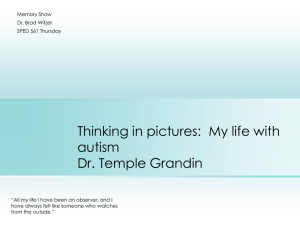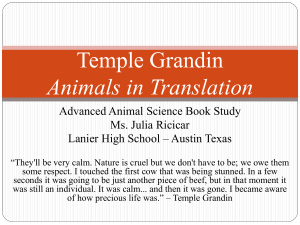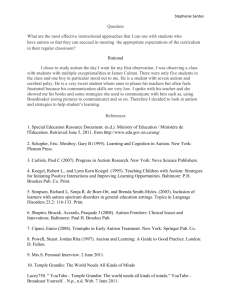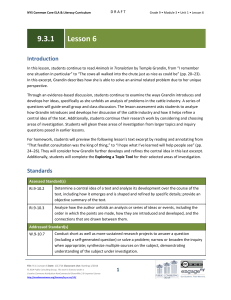Learning Sequence
advertisement
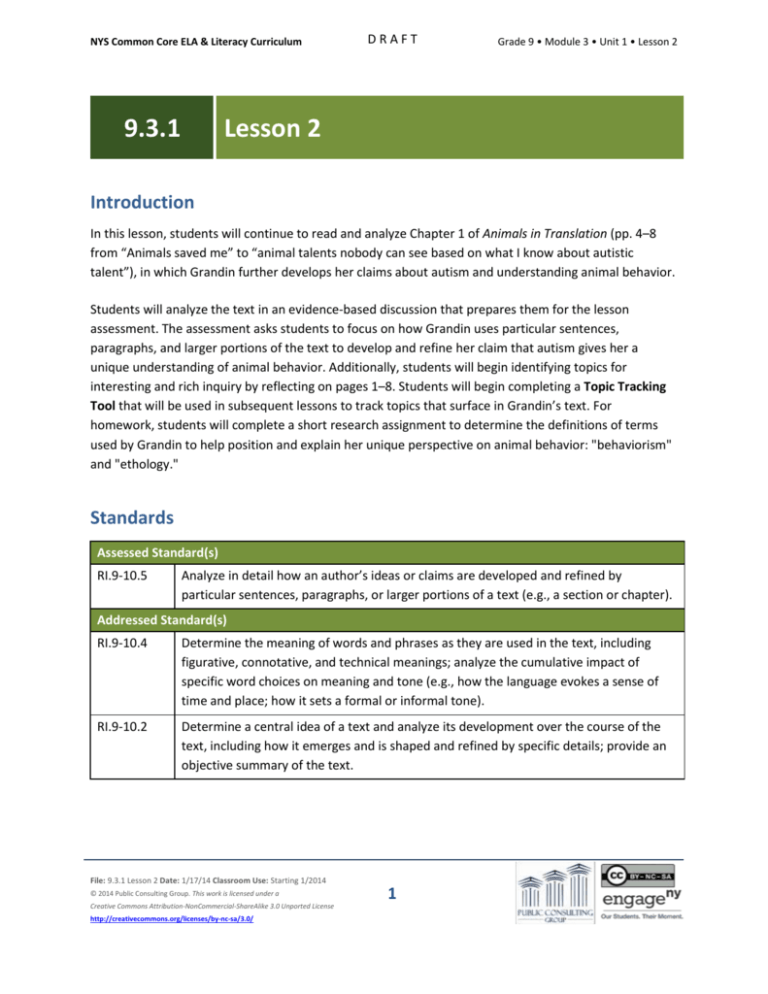
NYS Common Core ELA & Literacy Curriculum 9.3.1 DRAFT Grade 9 • Module 3 • Unit 1 • Lesson 2 Lesson 2 Introduction In this lesson, students will continue to read and analyze Chapter 1 of Animals in Translation (pp. 4–8 from “Animals saved me” to “animal talents nobody can see based on what I know about autistic talent”), in which Grandin further develops her claims about autism and understanding animal behavior. Students will analyze the text in an evidence-based discussion that prepares them for the lesson assessment. The assessment asks students to focus on how Grandin uses particular sentences, paragraphs, and larger portions of the text to develop and refine her claim that autism gives her a unique understanding of animal behavior. Additionally, students will begin identifying topics for interesting and rich inquiry by reflecting on pages 1–8. Students will begin completing a Topic Tracking Tool that will be used in subsequent lessons to track topics that surface in Grandin’s text. For homework, students will complete a short research assignment to determine the definitions of terms used by Grandin to help position and explain her unique perspective on animal behavior: "behaviorism" and "ethology." Standards Assessed Standard(s) RI.9-10.5 Analyze in detail how an author’s ideas or claims are developed and refined by particular sentences, paragraphs, or larger portions of a text (e.g., a section or chapter). Addressed Standard(s) RI.9-10.4 Determine the meaning of words and phrases as they are used in the text, including figurative, connotative, and technical meanings; analyze the cumulative impact of specific word choices on meaning and tone (e.g., how the language evokes a sense of time and place; how it sets a formal or informal tone). RI.9-10.2 Determine a central idea of a text and analyze its development over the course of the text, including how it emerges and is shaped and refined by specific details; provide an objective summary of the text. File: 9.3.1 Lesson 2 Date: 1/17/14 Classroom Use: Starting 1/2014 © 2014 Public Consulting Group. This work is licensed under a Creative Commons Attribution-NonCommercial-ShareAlike 3.0 Unported License http://creativecommons.org/licenses/by-nc-sa/3.0/ 1 NYS Common Core ELA & Literacy Curriculum DRAFT Grade 9 • Module 3 • Unit 1 • Lesson 2 Assessment Assessment(s) The learning in this lesson will be captured through a Quick Write at the end of the lesson. Students will answer the following prompt based on the close reading (citing evidence from the text and analyzing key words and phrases) completed in the lesson. Choose two sentences, paragraphs, or larger portions of this lesson’s text excerpt and analyze how they develop and refine one of Grandin’s claims about autism and animal behavior. This assessment will be evaluated using the Short Response Rubric. High Performance Response(s) A high performance response may include the following: On page 7, Grandin develops and refines her claim that autism has given her an advantage in understanding animals and ultimately helped her attain professional success. Grandin states, “Animal behavior was the right field for me, because what I was missing in social understanding I could make up for in understanding animals.” Grandin realizes the limitations of her autism and uses it to hone her talents in translating animal behavior. She continues to explain her success in the field characterized by her numerous accomplishments, including “over three hundred scientific papers” published and “half the cattle in the United States and Canada are handled in humane slaughter systems I’ve designed.” She attributes this success to the fact that her “brain works differently” because of her autism. Grandin develops and refines another claim, how autism allows her to think “the way animals think” on page 6. Grandin describes autism as a “way station on the road from animals to humans, which puts autistic people like me in a perfect position to translate ‘animal talk’ into English.” Grandin is able to comprehend why animals do the things they do unlike “normal” brained people and this is why her autism makes “animals easy” as opposed to normal people who cannot even recognize animal genius. Vocabulary Vocabulary to provide directly (will not include extended instruction) savants (n.) – people with unusual mental abilities that other people do not have Vocabulary to teach (may include direct word work and/or questions) riveted (v.) – to cause to be fixed or held firmly, as in fascinated attention neuroscientific (adj.) – pertaining to the study of the anatomy, physiology, biochemistry, and pharmacology of the nervous system File: 9.3.1 Lesson 2 Date: 1/17/14 Classroom Use: Starting 1/2014 © 2014 Public Consulting Group. This work is licensed under a Creative Commons Attribution-NonCommercial-ShareAlike 3.0 Unported License http://creativecommons.org/licenses/by-nc-sa/3.0/ 2 NYS Common Core ELA & Literacy Curriculum DRAFT Grade 9 • Module 3 • Unit 1 • Lesson 2 Lesson Agenda/Overview Student-Facing Agenda % of Lesson Standards & Text: Standards: RI.9-10.5, RI.9-10.4, RI.9-10.2 Text: Animals in Translation, Chapter 1, pages 4–8 Learning Sequence: 1. 2. 3. 4. 5. 6. Introduction of Lesson Agenda Homework Accountability Pages 4–8 Reading and Discussion Identifying Research Topics Quick Write Closing 1. 2. 3. 4. 5. 6. 5% 10% 40% 30% 10% 5% Materials Copies of Topic Tracking Tool for each student Student copies of the Short Response Rubric and Short Response Checklist (refer to 9.3.1 Lesson 1) Learning Sequence How to Use the Learning Sequence Symbol Type of Text & Interpretation of the Symbol 10% no symbol Percentage indicates the percentage of lesson time each activity should take. Plain text indicates teacher action. Bold text indicates questions for the teacher to ask students. Italicized text indicates a vocabulary word. Indicates student action(s). Indicates possible student response(s) to teacher questions. Indicates instructional notes for the teacher. Activity 1: Introduction of Lesson Agenda 5% Begin by reviewing the agenda and sharing the assessed standard for this lesson: RI.9-10.5. In this lesson, students continue to read Chapter 1 of Animals in Translation, pages 4–8 (from “Animals saved File: 9.3.1 Lesson 2 Date: 1/17/14 Classroom Use: Starting 1/2014 © 2014 Public Consulting Group. This work is licensed under a Creative Commons Attribution-NonCommercial-ShareAlike 3.0 Unported License http://creativecommons.org/licenses/by-nc-sa/3.0/ 3 NYS Common Core ELA & Literacy Curriculum DRAFT Grade 9 • Module 3 • Unit 1 • Lesson 2 me” to “animal talents nobody can see based on what I know about autistic talent.”) and analyze how Grandin further develops her claims about autism and understanding animal behavior. Students will then apply the reading analysis from pages 1–8 to begin surfacing possible research topics. Students look at the agenda. Students were introduced to RI.9-10.5 in Unit 9.2.3. Activity 2: Homework Accountability 10% Instruct students to take out their homework from the previous lesson. Students take out their homework. The homework from the previous lesson was the following: Reread and annotate pages 1–4 and preview the following lesson’s text excerpt by reading and annotating for central idea pages 4–8 (from “Animals saved me” to “animal talents nobody can see based on what I know about autistic talent”). Additionally, write a response to the following prompt: Using specific textual details, determine one central idea that is emerging in pages 4–8. Instruct students to examine their written response and annotation from pages 1–8 and choose four annotations that best exemplify the emerging central idea discussed in the written response. Students examine their written response and annotation from pages 1–8. Students then choose four annotations that best exemplify the emerging central idea discussed in the written response. Instruct students to complete a Turn-and-Talk with a partner about their four exemplar annotation from pages 1–8, specifically discussing why the annotation best supports the emerging central idea. Annotation discussed may include the following: Pages 1–4: o Star next to “It took me a long time to figure out that I see things about animals other people don’t,” (p. 1) – noting how Grandin understands animals in ways that other people do not o Star next to “Autism made school and social life hard, but made animals easy” (p. 1) – noting that Grandin understands animals because of her autism but it poses difficulties for her when it comes to social situations o Exclamation point next to “Dogs have dog noses” (p. 1) – noting that Grandin thinks about animals in ways that other people may not (she uses different ways of categorizing animals) further revealing she has a unique perspective on animals File: 9.3.1 Lesson 2 Date: 1/17/14 Classroom Use: Starting 1/2014 © 2014 Public Consulting Group. This work is licensed under a Creative Commons Attribution-NonCommercial-ShareAlike 3.0 Unported License http://creativecommons.org/licenses/by-nc-sa/3.0/ 4 NYS Common Core ELA & Literacy Curriculum DRAFT Grade 9 • Module 3 • Unit 1 • Lesson 2 o Exclamation point next to “because I got kicked out of high school for fighting” (p. 1) – noting that Grandin struggles in school because of her autism o Star next to “It was like a loop inside my head, it just ran over and over again” (p. 2) – noting that her autism causes her to be repetitive, which makes her peers tease her, revealing how autism makes social interaction difficult o Star next to “I think it was just one of my autism genes kicking into high gear” (p .4) – noting Grandin’s anxiety and how this made school even more difficult for her Pages 4–7: o Star near the line “I got through my teenage years thanks to my squeeze machine and my horses. Animals kept me going” (p. 5) – noting Grandin’s comment earlier that autism made animals easy. It seems to be a reciprocal relationship for her. o Star near the line “Autistic people can think the way animals think” (p. 6) – noting Grandin’s connection to her earlier idea about autism making animals easy o Star near the line “Animal behavior was the right field for me, because what I was missing in social understanding I could make up for in understanding animals” (p. 7) – noting Grandin understands her limitations and strengths concerning her autism o Exclamation point near the line “Autism has given me another perspective on animals most professionals don’t have” (p. 7) – noting Grandin feels confident about her professional abilities due to her autism Page 8: o Star near the line “Animals are like autistic savants.” – This is Grandin’s claim about animal intelligence. She might try to prove this in the text and it further shows that because she is autistic, she might be better posed to prove an idea like this. o Star near the line “Normal people never have the special talents animals have, so normal people don’t know what to look for” – noting Grandin’s support for why autism makes understanding animals easier Circulate around the room to monitor the pair discussion. Listen for students to discuss the above annotation in support of emerging central ideas from the text including: Grandin’s autism gives her a unique perspective on animals and Grandin’s autism makes school and social life difficult but animals easy. Activity 3: Pages 4–8 Reading and Discussion 40% Introduce the Quick Write assessment (choose either two sentences, paragraphs, or larger portions of this lesson’s text excerpt and analyze how they develop and refine one of Grandin’s claims about autism and animal behavior). Explain to students that this is the lesson assessment and the focus for today’s reading. File: 9.3.1 Lesson 2 Date: 1/17/14 Classroom Use: Starting 1/2014 © 2014 Public Consulting Group. This work is licensed under a Creative Commons Attribution-NonCommercial-ShareAlike 3.0 Unported License http://creativecommons.org/licenses/by-nc-sa/3.0/ 5 NYS Common Core ELA & Literacy Curriculum DRAFT Grade 9 • Module 3 • Unit 1 • Lesson 2 Students examine the Quick Write assessment and listen. Display the Quick Write assessment. Instruct students to keep this assessment in mind as they analyze the text during the following evidencebased activity. Remind students to keep track of the text analysis by taking notes and annotating the text. Instruct students to take out their annotated copy of Animals in Translation, Chapter 1 and turn to page 4. Instruct students to reread in pairs from “Animals saved me” to “Now people are cut off from animals unless they have a dog or a cat” (pp. 4–5). Students take out their annotated copies of Animals in Translation, Chapter 1 and reread page 4 with a partner. Ask students the following questions: Differentiation Consideration: Consider having student pairs discuss the questions before asking them in a whole-class setting. What does the squeeze chute passage reveal about Grandin’s relationship to animals? It shows how deeply connected she feels to animals and their experiences. The passage demonstrates how animals “saved” her by showing her that she needed a squeeze machine similar to the cows. She was able to get through her anxiety during her teenage years “thanks” to her squeeze machine, which was inspired by cows going into their own squeeze chutes. How does Grandin demonstrate that she was “riveted” by the sight of those big animals inside the squeeze chute? What does Grandin mean by riveted in this excerpt? She has her aunt “stop the car so [she] could get out and watch.” She is fascinated by seeing the cows go through the squeeze chute, so riveted could mean extremely focused or fascinated by. Why might Grandin state that, “People and animals are supposed to be together”? Grandin has a strong connection to animals and sees how animals can be helpful to people, as she experienced in her own life: “Animals kept me going.” Instruct students to reread in pairs from “Horses are especially good for teenagers” to “But it would work a lot better if military schools still had horses” (pp. 5–6). Ask students the following question: File: 9.3.1 Lesson 2 Date: 1/17/14 Classroom Use: Starting 1/2014 © 2014 Public Consulting Group. This work is licensed under a Creative Commons Attribution-NonCommercial-ShareAlike 3.0 Unported License http://creativecommons.org/licenses/by-nc-sa/3.0/ 6 NYS Common Core ELA & Literacy Curriculum DRAFT Grade 9 • Module 3 • Unit 1 • Lesson 2 Differentiation Consideration: Consider having student pairs discuss the question before discussing it in a whole-class setting. What does Grandin explain about the instinctual nature of horseback riding? How does this explanation further develop the central ideas of the text? Grandin explains that “a good rider and his horse are a team.” There is a mutual relationship between both rider and horse: “It’s a relationship.” Grandin is showing that she understands the relationship between a horse and rider; she can relate to animals, specifically horses, in this way: “Yet there I was, moving my body in sync with the horse’s body to help him run right.” This understanding continues to show how Grandin understands animals due to her autism and her own experiences/background. Instruct students to reread in pairs from “Animals in Translation comes out of forty years I’ve spent with animals” to “They just don’t know what it is, or how to describe it” (pp. 6–7) in pairs. Students reread pages 6–7 in pairs. Ask students to do a Turn-and-Talk with a classmate discussing the various ways in which Grandin explains how she is “different from every other professional who works with animals.” Lead a whole-class share out of the pair discussion. Student responses should include the following: o o o Grandin states that “Autistic people can think the way animals think” (p. 6). Therefore, she is saying that since she is autistic she can understand animal behavior because she can think like an animal. Grandin says that “Autism is a kind of way station on the road from animals to humans” (p. 6) making her the perfect person to translate “‘animal talk’ into English.” Grandin says that her “brain works differently” (p. 7) and that is why she has been successful in the field of translating animal behavior. Autism has given her a different “perspective” on animals that other professionals do not have. Instruct students to reread in pairs from “I stumbled across the answer, or what I think is part of the answer” to “a difference in the brain autistic people share with animals” (pp. 7–8). Define the word savants (people with unusual mental abilities that other people do not have) and instruct students to write the definition on their text. File: 9.3.1 Lesson 2 Date: 1/17/14 Classroom Use: Starting 1/2014 © 2014 Public Consulting Group. This work is licensed under a Creative Commons Attribution-NonCommercial-ShareAlike 3.0 Unported License http://creativecommons.org/licenses/by-nc-sa/3.0/ 7 NYS Common Core ELA & Literacy Curriculum DRAFT Grade 9 • Module 3 • Unit 1 • Lesson 2 Students write the definition of savants on their text and then reread pages 7–8 in pairs. Direct students to Grandin’s discussion of “neuroscientific research” on page 7 (“Because of my own problems, I‘ve always followed neuroscientific research on the human brain as closely as I’ve followed my own field.”) Ask students to think about the root word neur and what it could refer to based on the sentence. The brain Ask students to do a Turn-and-Talk with a classmate synthesizing Grandin’s claim about autistic savants and animals and what led her to this claim. Have the class share the outcome of the pair discussion. Student responses should include the following: o o Animals are like autistic savants because their brains and talents are similar: “at least some animals have special forms of genius normal people don’t, the same way some autistic savants have special forms of genius” (p. 8). Grandin makes this claim based on her reading of “neuroscientific research” and autistic savants. She is able to make a “connection between human intelligence and animal intelligence the animal sciences have missed” (p. 7) because of her research and interest in the topics. Instruct students to reread in pairs from “The reason we’ve managed to live with animals all these years” to “animal talents nobody can see based on what I know about autistic talent” (p. 8). Students reread page 8 in pairs. Ask students the following question: Differentiation Consideration: Consider having student pairs discuss the question before discussing it in a whole-class setting. What is Grandin exploring or researching? How does this exploration or research further develop a central idea in the text? Student responses should include: o Grandin is looking for specific animal talents where animals show how they can “perceive” (understand, identify, or become aware of things) that humans cannot and to remember “detailed information” that humans cannot remember. File: 9.3.1 Lesson 2 Date: 1/17/14 Classroom Use: Starting 1/2014 © 2014 Public Consulting Group. This work is licensed under a Creative Commons Attribution-NonCommercial-ShareAlike 3.0 Unported License http://creativecommons.org/licenses/by-nc-sa/3.0/ 8 NYS Common Core ELA & Literacy Curriculum o o DRAFT Grade 9 • Module 3 • Unit 1 • Lesson 2 Grandin is saying that her autistic mind gives her a unique perspective on animal behavior and she has an advantage in identifying animal talents that “normal people” cannot. She is able to “predict animal talents nobody can see based on what I know about autistic talent” (p. 8). Activity 4: Identifying Research Topics 30% Share with students that they have been reading closely and analyzing texts (in the previous two modules) for several purposes, including evidence-based discussion and writing. Share with students that this type of reading is also about deepening understanding. This understanding can be about a variety of things like authorial choices when analyzing literature, or it can be about learning and thinking in depth about a topic you want to know more about. For the purposes of this module, the text analysis is about analyzing the text itself, based on the standards, but also about surfacing topics that are potentially interesting and rich to research. These initial topics will begin the inquiry process. As the process unfolds, aspects of the topics will develop as questions are posed and refined and pre-research is conducted. Students listen. Distribute the Topic Tracking Tool to each student. Students examine the Topic Tracking Tool. See the end of the lesson for an example Topic Tracking Tool. Inform students that they will be reviewing pages 1–8 by thinking about the following question: What topics does Grandin surface or address in this part of the text? Instruct students to review pages 1–8 and write down key topics that surface in the text in column 1 on the Topic Tracking Tool. Instruct students to only complete column 1 for now. Students review pages 1–8 and complete column 1 of the Topic Tracking Tool by writing down key topics surfacing in this part of the text. Lead a whole-class discussion about the topics Grandin surfaces. Student responses may include the following: o o o o o Autism The link between autism and understanding animal behavior Animal behavior Animals helping emotionally disturbed people Developmental disorders File: 9.3.1 Lesson 2 Date: 1/17/14 Classroom Use: Starting 1/2014 © 2014 Public Consulting Group. This work is licensed under a Creative Commons Attribution-NonCommercial-ShareAlike 3.0 Unported License http://creativecommons.org/licenses/by-nc-sa/3.0/ 9 NYS Common Core ELA & Literacy Curriculum o o o DRAFT Grade 9 • Module 3 • Unit 1 • Lesson 2 Animal intelligence Autistic savants Neuroscience Consider displaying notes on the discussion so students can see the various topics. Model for students how to complete columns 2 and 3 of the Topic Tracking Tool by identifying one topic, page number(s) where the topic is discussed, and key information about the topic from the text. Students listen and follow along with the modeling. See the Model Topic Tracking Tool at the end of the lesson for possible modeling content. Instruct students to individually complete at least three more rows of the Topic Tracking Tool for the topics surfaced during the previous text review. Remind students that new topics will emerge in each portion of Animals in Translation and they should record all possible topics for research. Students individually complete at least three more rows of the Topic Tracking Tool for the topics surfaced during the previous text review. Circulate around the room to ensure students understand how to complete the Topic Tracking Tool. See model student responses at the end of the lesson. Activity 5: Quick Write 10% Instruct students to respond briefly in writing to the following prompt: Choose either two sentences, paragraphs, or larger portions of this lesson’s text excerpt and analyze how they develop and refine one of Grandin’s claim about autism and animal behavior. Remind students to use the Short Response Checklist and Short Response Rubric to guide their written responses. Display the prompt for students to see, or provide the prompt in hard copy. Students independently answer the prompt using evidence from the text. See the High Performance Response at the beginning of this lesson. Activity 6: Closing 5% Display and distribute the homework assignment. For homework, instruct students to complete a short research assignment to determine the definitions of the following terms: behaviorism and ethology. File: 9.3.1 Lesson 2 Date: 1/17/14 Classroom Use: Starting 1/2014 © 2014 Public Consulting Group. This work is licensed under a Creative Commons Attribution-NonCommercial-ShareAlike 3.0 Unported License http://creativecommons.org/licenses/by-nc-sa/3.0/ 10 NYS Common Core ELA & Literacy Curriculum DRAFT Grade 9 • Module 3 • Unit 1 • Lesson 2 Students will conduct a web search, finding resources that define and explain both terms. These resources should include common online reference materials and other online resources such as audio and video. Students will need to unpack the definitions and/or explanations of both sciences by answering the following prompt: Explain, in your own words, the terms behaviorism and ethology. How do the resources you found help you understand these terms? Homework Conduct a web search of the following terms, which will be referenced in the next excerpt we will be reading from Grandin's chapter 1. Behaviorism Ethology Explain, in your own words, the terms behaviorism and ethology. How do the resources you found help you understand these terms? File: 9.3.1 Lesson 2 Date: 1/17/14 Classroom Use: Starting 1/2014 © 2014 Public Consulting Group. This work is licensed under a Creative Commons Attribution-NonCommercial-ShareAlike 3.0 Unported License http://creativecommons.org/licenses/by-nc-sa/3.0/ 11 DRAFT NYS Common Core ELA & Literacy Curriculum Grade 9 • Module 3 • Unit 1 • Lesson 2 Topic Tracking Tool Name: Topic Class: Date: Page Number(s) Key Information About the Topic from the Text From Odell Education Researching to Deepen Understanding Framework, by Odell Education, www.odelleducation.com. Copyright (2012) by Odell Education. Adapted with permission under an AttributionNonCommercial 3.0 Unported license: http://creativecommons.org/licenses/by-nc/3.0/. File: 9.3.1 Lesson 2 Date: 1/17/14 Classroom Use: Starting 1/2014 © 2014 Public Consulting Group. This work is licensed under a Creative Commons Attribution-NonCommercial-ShareAlike 3.0 Unported License http://creativecommons.org/licenses/by-nc-sa/3.0/ 12 DRAFT NYS Common Core ELA & Literacy Curriculum Grade 9 • Module 3 • Unit 1 • Lesson 2 Model Topic Tracking Tool Name: Class: Date: Topic Page Number(s) Key Information About the Topic from the Text The link between autism and understanding animal behavior 6–8 Grandin believes she has a unique perspective on animals because of her autism. She says, “Normal people never have the special talents animals have, so normal people don’t know what to look for.” Animals can help emotionally disturbed people. 2–3, 5 Grandin understood the emotionally disturbed animals at her boarding school because of her own emotional issues. Kids who have emotional problems will do better if they are horseback riding: “the rider will end up doing better than the nonrider.” Developmental Disorders (Autism, Obsessive-Compulsive Disorder) 1, 4 Grandin has autism. She says it poses difficulties: “Autism made school and social life hard” but also advantages: “but it made animals easy.” Autistic Savants 7 Grandin thinks autistic savants share similar brains to animals that “animals are like autistic savants.” Animal Intelligence 8 Gradin claims, “Animal genius is invisible to the naked eye.” She writes about using animal talents and intelligence for the betterment of humans and animals. From Odell Education Researching to Deepen Understanding Framework, by Odell Education, www.odelleducation.com. Copyright (2012) by Odell Education. Adapted with permission under an AttributionNonCommercial 3.0 Unported license: http://creativecommons.org/licenses/by-nc/3.0/. File: 9.3.1 Lesson 2 Date: 1/17/14 Classroom Use: Starting 1/2014 © 2014 Public Consulting Group. This work is licensed under a Creative Commons Attribution-NonCommercial-ShareAlike 3.0 Unported License http://creativecommons.org/licenses/by-nc-sa/3.0/ 13
